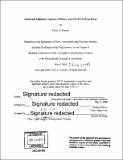| dc.contributor.advisor | Richard Binzel. | en_US |
| dc.contributor.author | Kramer, Emily Anne | en_US |
| dc.contributor.other | Massachusetts Institute of Technology. Department of Earth, Atmospheric, and Planetary Sciences. | en_US |
| dc.date.accessioned | 2018-03-27T14:18:33Z | |
| dc.date.available | 2018-03-27T14:18:33Z | |
| dc.date.copyright | 2008 | en_US |
| dc.date.issued | 2008 | en_US |
| dc.identifier.uri | http://hdl.handle.net/1721.1/114347 | |
| dc.description | Thesis: S.B., Massachusetts Institute of Technology, Department of Earth, Atmospheric, and Planetary Sciences, 2008. | en_US |
| dc.description | Cataloged from PDF version of thesis. | en_US |
| dc.description | Includes bibliographical references (page 34). | en_US |
| dc.description.abstract | Binary asteroids have been insightful to scientists in recent years in their quest to better understand the Solar System in its early stage. Observing a mutual event between a primary and its moon can yield the sizes of the objects in units of the semi-major axis a. When the linear dimensions of the orbit can be known, Kepler's Third Law allows for a solution of the mass. As an example, because the absolute linear scale of (22) Kalliope/Linus is known [1], one can determine the component sizes and reduce error bars on the mass and density of this M-type asteroid. Since the bulk composition is known from spectral data, the porosity of the asteroid can be calculated. Knowing the porosity of the asteroid can give scientists a better understanding of its formation and dynamical evolution. Binary object (22) Kalliope/Linus is a classic example of a system for which this technique can yield valuable results. An observing campaign involving five observers resulted in twenty-eight nights of data. The data were used to create rotational lightcurves, which were scanned for signatures of mutual events. | en_US |
| dc.description.statementofresponsibility | by Emily A. Kramer. | en_US |
| dc.format.extent | 35 pages | en_US |
| dc.language.iso | eng | en_US |
| dc.publisher | Massachusetts Institute of Technology | en_US |
| dc.rights | MIT theses are protected by copyright. They may be viewed, downloaded, or printed from this source but further reproduction or distribution in any format is prohibited without written permission. | en_US |
| dc.rights.uri | http://dspace.mit.edu/handle/1721.1/7582 | en_US |
| dc.subject | Earth, Atmospheric, and Planetary Sciences. | en_US |
| dc.title | Rotational lightcurve analysis of binary Asteroid (22) Kalliope/Linus | en_US |
| dc.type | Thesis | en_US |
| dc.description.degree | S.B. | en_US |
| dc.contributor.department | Massachusetts Institute of Technology. Department of Earth, Atmospheric, and Planetary Sciences | |
| dc.identifier.oclc | 1028750209 | en_US |
